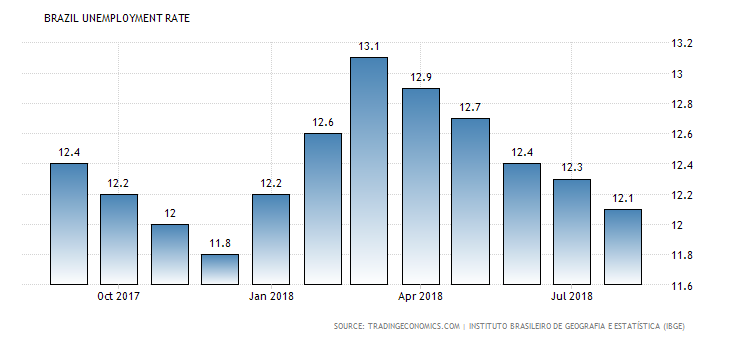Update on Brazil – October 2018
In a report published at the end of September 2018, the Brazilian Central Bank (and the IMF) reduced their annual economic growth forecast for Brazil for 2018 down to 1.4%, which is less than half of the projected global economic growth of 3.7% for the current year. The main reason for this dismal result in Brazil is essentially political – the country’s economy is virtually at a standstill, pending the outcome of the October presidential election, which will occur on October 28th, when the second (and final ) voting round will take place. The first round, on October 7th resulted in a right wing and virtually unknown candidate, obtaining 46 % of the votes, followed by the workers’ party (PT) which received 29 % of the votes.
Brazil is still struggling to rid itself of the worst economic crisis that it has ever faced, and which resulted in a severe recession (reduction of almost 10% in per capita GDP, during 2015/6), with a timid recovery over the last two years. This was mostly caused by (i) a series of wrong economic policies; (ii) an unfavorable international environment; (iii) a massive public sector corruption scheme (at least USD 2 billion in deviated funds), which discredited the Government and (iv) an irresponsible populist fiscal policy, which led to a sizeable increase of public sector debt. The combination of these factors resulted in a severe political crisis. The uncertainty of the presidential election outcome also contributed to investments of the private sector remaining practically stopped. These combined factors led to a very high (and record) unemployment level –according to the Brazilian Geographic and Statistics Institute (IBGE), the unemployment rate at the end of August 2018 was still 12.1%, a slight reduction compared to the figures for the previous quarter. In absolute numbers, approximately 13 million people remain out of work.

This has affected all levels of employment, from blue collar workers to top executives. Uncertainties have prompted companies to postpone investments and exchange higher paid employees for “cheaper” ones, as well as eliminate layers of functions, whenever possible. The offer of qualified professionals greatly exceeds demand, and many qualified Brazilian executives have been seeking employment outside of the country. At year end 2017, 10.32% of employed people worked in Agriculture; 20.85% in Industry and 68.83% in Services. Among the sectors which currently have larger numbers of unemployment are Construction / Real Estate, Heavy Construction, Capital Goods, and Ship Building. Financial Services remains flat in terms of hiring demand; but Services geared to the end consumer have also been hit hard by the crisis. It is expected that, irrespective of which party wins the presidential election, one of the sectors that will probably receive a priority to “jump-start” economic growth will be the Construction sector – Brazil historically has a large bottleneck in the terms of Infrastructure development. Agribusiness continues to be strong, particularly those companies which are export-oriented.
Another sector which is beginning to recover and increase hiring is the Oil & Gas sector. On September 28th, all four blocks offered in the most recent round of Production-sharing bids sponsored by the National Petroleum Natural Gas & Biofuels agency (ANP), in the pre-salt areas were awarded to foreign Oil & Gas companies, which paid USD 1.7 billion in signing bonuses to the Brazilian Government.







